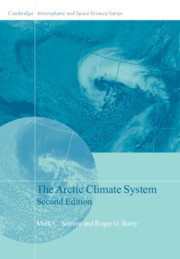Book contents
- Frontmatter
- Dedication
- Contents
- Preface
- Acknowledgments
- List of Acronyms
- List of Selected Web Sites
- 1 The Evolution of Knowledge about the Arctic and Its Climate
- 2 Physical Characteristics and Basic Climatic Features
- 3 The Basic Atmospheric and Ocean Energy Budgets
- 4 The Atmospheric Circulation
- 5 Energy Exchanges at the Surface
- 6 Precipitation, Net Precipitation, and River Discharge
- 7 Arctic Ocean–Sea Ice–Climate Interactions
- 8 Climate Regimes of the Arctic
- 9 Modeling the Arctic Climate System
- 10 Arctic Paleoclimates
- 11 The Uncertain Future
- References
- Index
- Plate Section
3 - The Basic Atmospheric and Ocean Energy Budgets
Published online by Cambridge University Press: 05 August 2014
- Frontmatter
- Dedication
- Contents
- Preface
- Acknowledgments
- List of Acronyms
- List of Selected Web Sites
- 1 The Evolution of Knowledge about the Arctic and Its Climate
- 2 Physical Characteristics and Basic Climatic Features
- 3 The Basic Atmospheric and Ocean Energy Budgets
- 4 The Atmospheric Circulation
- 5 Energy Exchanges at the Surface
- 6 Precipitation, Net Precipitation, and River Discharge
- 7 Arctic Ocean–Sea Ice–Climate Interactions
- 8 Climate Regimes of the Arctic
- 9 Modeling the Arctic Climate System
- 10 Arctic Paleoclimates
- 11 The Uncertain Future
- References
- Index
- Plate Section
Summary
Overview
The fundamental role of the Arctic in the global climate system is to serve as the Northern Hemisphere “heat sink.” On an annual basis, net receipts of solar radiation in the Arctic are smaller than in equatorial regions. The atmosphere and ocean work to balance this differential radiative heating through poleward energy transports, with the atmosphere playing the primary role. Because of stronger differential radiative heating in winter, the atmospheric transports are largest at this time. The poleward transports into the Arctic region itself are maximized around the prime meridian and the date line. This reflects the location of the primary storm tracks and, in winter, strong surface heat fluxes from open water areas.
An instructive approach to understand the energetics of the Arctic heat sink is to consider the system from the perspective of its energy budget. The energy budget of a given column of air, extending from the surface to the top of the atmosphere, can be expressed in terms of four components: (1) the change in atmospheric energy storage composed of internal energy, potential energy, latent heat energy and kinetic energy, the last generally quite small; (2) the net radiation balance at the top of the atmosphere; (3) the net poleward transport of atmospheric energy by the atmospheric circulation; and (4) the net surface heat flux. The energy of a given underlying column extending, from the surface downward, if represented by ocean, is approximately represented by: (1) the change in ocean energy storage in terms of latent heat as floating sea ice and any overlying snow cover, and in the sensible heat of the ocean water; (2) the horizontal convergence of the oceanic sensible heat flux and the horizontal divergence of the latent heat flux as sea ice; and (3) the net surface heat flux through which the atmosphere and ocean communicate. If the underlying column represents land, the situation is simpler. Here, the time changes in energy storage, primarily contained in the latent heat content of snow and ice and sensible heat in the soil column, is essentially balanced by the net surface flux.
- Type
- Chapter
- Information
- The Arctic Climate System , pp. 65 - 84Publisher: Cambridge University PressPrint publication year: 2014
- 2
- Cited by



